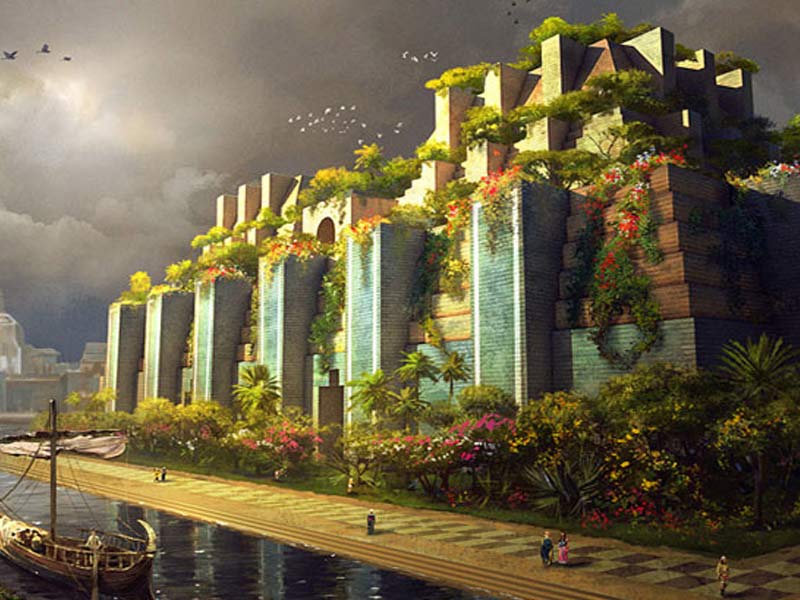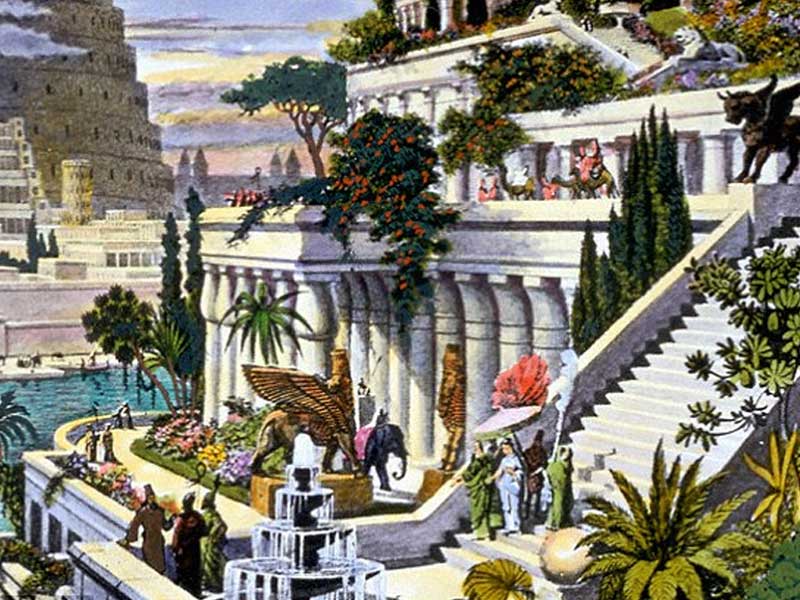Hanging Gardens of Babylon, one of the most remarkable engineering marvels of the ancient world, were one of the Seven wonders of the ancient world.
As per the legends, the Hanging Gardens of Babylon were tiered gardens constructed ascending, just like steps. The hanging gardens had a vast range of trees, vines, and shrubs. The garden was created using mud bricks and is said to have been built in the ancient city of Babylon, one of the wealthiest cities of the ancient world. Babylon was in Babil province in Iraq. The name hanging garden was derived from a Greek word called kremastos that translates into English as ‘overhanging.’ The word kremastos refers to plantations on raised structures.
If legends are believed, the Hanging Gardens of Babylon were built near a grand palace called The Marvel of Mankind by the Neo Babylonian king Nebuchadnezzar II. The king built the gardens for his wife, Queen Amytis. Several historical texts, including the writings by Babylonian priest Berossus, mention the Gardens of Babylon. However, there are several reservations over the existence of Hanging Gardens.

The reason behind them is the only one of the Seven Wonders for which the location has not been definitively established. Also, leading historical texts in Babylon do not find any mention of Hanging Gardens.
These are the reasons that give birth to three different theories related to the existence of the Hanging Gardens of Babylon. The first theory suggests that the Hanging Gardens are purely mythical. The second theory suggests that the gardens did exist somewhere in Babylon. Still, they were destroyed around the first century AD. The third theory is that the legends refer to another garden built by Assyrian king Sennacherib in his capital city of Nineveh on the Tigris river.
The theory that the Hanging Gardens are purely mythical can not be completely ruled out. A key reason to back this theory is that there is no mention of Amytis, the wife of Nebuchadnezzar II, in historical texts. Also, there are no existing texts from the Babylonian era that mention the gardens. Archaeologists have also been unable to find any proof that validates the existence of Hanging Gardens. The theory appears to be true all the more because historical texts mention King Nebuchadnezzar II and his works. But the same texts do not mention his so-called wife Amytis or the gardens.
Also Read, Ancient World’s Top Seven Wonders That You Should Know About
The theory that Hanging Gardens of Babylon were actually well-documented gardens constructed by the Assyrian king Sennacherib for his palace in Nineveh was actually coined by Oxford scholar Stephanie Dalley. Dalley claimed that the claims about Hanging Gardens were actually a result of conflution between intervening centuries when some associated the breathtaking gardens built by King Sennacherib for his palace to Nebuchadnezzar’s garden.

The true location of the Hanging Gardens of Babylon remains a mystery. No discovery of any archaeological evidence or historical texts that hint at the existence of Hanging Gardens has been made yet.
But if we consider Hanging Gardens to be true, why was it placed among the 7 ancient wonders of the world? They were built by King Nebuchadnezzar II between 605 and 562 BCE. Babylon is located 80 km south of modern Baghdad. It was an ancient city. The settlement of Babylon can be traced back to the 3rd millennium BCE. It was the capital city of the Neo-Babylonian empire, and it was built by Nebuchadnezzar’s father, Nabopolassar, after he defeated the Assyrian empire.
Babylonian kings wanted to develop Babylon as one of the most amazing cities in the world. This is what inspired the construction of the world-famous Hanging Gardens of Babylon.
While the limited historical texts that mention Hanging Gardens of Babylon claim that the gardens had a vast range of plantations, most scholars believe that the gardens were built purely for pleasure. During that period, the wealthy individuals or those having private homes cultivated private gardens in their homes. Apart from its vast plantations, the Hanging Gardens were popular for high stone terraces that appeared like mini mountains from a distance.

All these efforts were put in to make queen Amytis feel less homesick. She came from a hilly place and started missing her hometown badly after coming to Babylon following her marriage. But all these claims can’t be validated as there’s no mention of Queen Amytis in the existing historical texts.




























